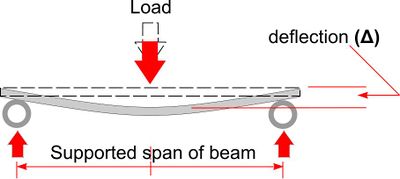Beam Deflection: Difference between revisions
From DT Online
m (Corrected Link) |
mNo edit summary |
||
| Line 1: | Line 1: | ||
The deflection of a beam under load may be measured using a dial gauge for example but may also be calculated. | The deflection of a beam under load may be measured using a dial gauge for example but may also be calculated. | ||
[[File:DeflectionCalc.png|300px|right]] | |||
The equation opposite gives [https://en.wikipedia.org/wiki/Deflection_%28engineering%29 '''Deflection (Δ)'''] of a simply supported beam loaded in the centre. | The equation opposite gives [https://en.wikipedia.org/wiki/Deflection_%28engineering%29 '''Deflection (Δ)'''] of a simply supported beam loaded in the centre. | ||
| Line 14: | Line 14: | ||
* I = '''[[Moment of Inertia]]''' ''( - a measure of the capacity of a cross section to resist '''[[Bending Strength|bending]]''')'' | * I = '''[[Moment of Inertia]]''' ''( - a measure of the capacity of a cross section to resist '''[[Bending Strength|bending]]''')'' | ||
---- | |||
[[Category:Secondary]] | [[Category:Secondary]] | ||
[[Category:Beams]] | [[Category:Beams]] | ||
Revision as of 07:27, 11 March 2016
The deflection of a beam under load may be measured using a dial gauge for example but may also be calculated.
The equation opposite gives Deflection (Δ) of a simply supported beam loaded in the centre.
Where:
- W = Load
- L = Span
- E = Young's Modulus ( - a measure of how stiff the materials is)
- I = Moment of Inertia ( - a measure of the capacity of a cross section to resist bending)

